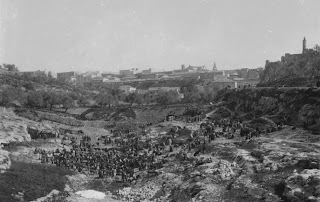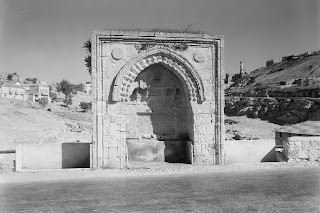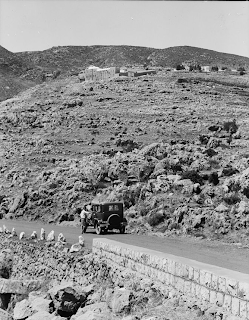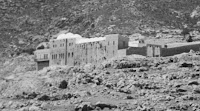Uncovered in Jerusalem,
9 tiny unopened Dead Sea Scrolls
Researcher finds tantalizing tefillin parchments
from Second Temple era, overlooked for decades
and unread for 2,000 years
BY ILAN BEN ZION March 12, 2014
Ilan Ben Zion Ilan Ben Zion is a news editor at The Times of Israel. He holds a Masters degree in Diplomacy from … [More]
Follow or contact:
RSS
They’re not much larger than lentils, but size doesn’t minimize the potential significance of nine newfound Dead Sea Scrolls that have lain unopened for the better part of six decades.
Get The Times of Israel's Daily Edition by email
and never miss our top stories FREE SIGN UP!
An Israeli scholar turned up the previously unexamined parchments, which had escaped the notice of academics and archaeologists as they focused on their other extraordinary finds in the 1950s. Once opened, the minuscule phylactery parchments from Qumran, while unlikely to yield any shattering historic, linguistic or religious breakthroughs, could shed new light on the religious practices of Second Temple Judaism.
The Israel Antiquities Authority has been tasked with unraveling and preserving the new discoveries — an acutely sensitive process and one which the IAA says it will conduct painstakingly, and only after conducting considerable preparatory research.
Phylacteries, known in Judaism by the Hebrew term tefillin, are pairs of leather cases containing biblical passages from the books of Exodus and Deuteronomy. One case is bound by leather thongs to the head and one to the arm during morning prayers, as prescribed by rabbinic interpretation of the Bible. The case worn on the head contains four scrolls in individual compartments, while the arm phylactery holds one scroll.
The interior of the Shrine of the book, the home of the Dead Sea Scrolls at the Israel Museum. (photo credit: Flash90)
At least two dozen tefillin scroll fragments were known to have been found during excavations of the limestone caves overlooking the Dead Sea at Qumran in the 1950s (several phylactery boxes and straps were unearthed as well). They were among the world-famous cache of thousands of scrolls and scroll fragments containing biblical and sectarian texts from the Second Temple period. Since their discovery, the Qumran scrolls have been housed at the Israel Museum, and scholars have pored over the ancient documents and opened a window into ancient Jewish theology.
But these nine latest tiny scrolls had been overlooked — until now.
Dr. Yonatan Adler, a lecturer at Ariel University and a post-doctoral researcher on Qumran tefillin at Hebrew University, was searching through the Israel Antiquities Authority’s climate-controlled storerooms in the Har Hotzvim neighborhood of Jerusalem in May 2013. There he found a phylactery case from Qumran among the organic artifacts stored in climate-controlled warehouses. Suspecting the case could contain a heretofore undocumented scroll, he had it scanned by an MRI at Shaare Zedek Hospital. The analysis suggested there might indeed be an unseen parchment inside.
While that analysis has yet to be confirmed, Adler was spurred on by the discovery, and in December visited the Dead Sea Scroll labs at the Israel Museum. There he found two tiny scrolls inside the compartments of a tefillin case that had been documented but then put aside some time after 1952. The scrolls were never photographed or examined, and so have remained bound inside the leather box for roughly 2,000 years.
Then, just last month, Adler told The Times of Israel he “found a number of fragments of tefillin cases from Qumran Cave 4, together with seven rolled-up tefillin slips” which had never been opened.
Dr. Yonatan Adler of Ariel University (photo credit: Devorah Adler)
“Either they didn’t realize that these were also scrolls, or they didn’t know how to open them,” Pnina Shor, head of the IAA’s Department of Artefact Treatment and Conservation, explained.
Józef Tadeusz Milik, the most prolific publisher of the scrolls after their discovery last century, reported on the Cave 4 tefillin case finds but he “didn’t say why they didn’t open them, [and] he also didn’t say they were scrolls,” even though the parchments were identified as part of tefillin assemblage, she said.
Shor and her team have managed the painstakingtask of maintaining the thousands of scroll fragments found at Qumran, removing them from the glass casings in which they were entombed in the 1950s and mounting them on fine cloth mesh, then digitizing each minute scrap with multi-spectral photography. Each scroll fragment is photographed at 56 different exposures — 28 per side (as some scrolls have writing on both) — in 12 different wavelengths ranging as far as the infrared. The team will be tasked with a similar mission with the new scrolls once they’ve been opened.
Dead Sea Scroll expert Eibert Tigchelaar of the University of Leuven in Belgium said that the fact that these nine scrolls went undetected for so long should not come as a surprise, considering the scrolls’ complicated administrative history (which includes a change in sovereignty in 1967). ”Things physically remained somewhere, but administratively were forgotten,” Tigchelaar said.
Moreover, “confronted with 10,000 or more fragments from Cave 4, of which the last were only published a few years ago, there was little attention [paid] to those tefillin that might not be opened at all,” he said.
None of the phylacteries has been radiocarbon dated, but the cache of scrolls and religious objects from the caves at Qumran date from the second and first centuries BCE and first century CE — a critical time in the development of Judaism and early Christianity.
Like many of the finds at Qumran, some of the tefillin slips that have previously been opened have yielded astonishing differences from the standard Rabbinic text known as the Masoretic.
“Some tefillin use a spelling very close to the traditional one, [but] there are several tefillin that use an extreme form of divergent spelling that also occurs in many other scrolls,” such as additional letters in possessive suffixes, Tigchelaar said.
Seven recently rediscovered unopened tefillin scrolls from Qumran. (photo credit: Shai Halevi via Israel Antiquities Authority)
Professor Lawrence Schiffman, a vice provost at Yeshiva University and expert on Second Temple Judaism, explained that some of the tefillin texts from Qumran were identical to those used today, but others have the same text with additional passages, extended to include the Ten Commandments. He also pointed out that it would be interesting to see the order in which the scrolls were placed inside the tefillin compartments — a practice debated by rabbis for centuries.
“From my point of view, the most significant thing about all of this is that they actually have tefillin from 2,100 and plus years ago,” Schiffman said of the Dead Sea Scrolls generally. The continuity of phylactery traditions — over the centuries and across the various sects that comprised Second Temple Jewry — was something he found remarkable.
“We have to be prepared for surprises,” Professor Hindy Najman of Yale University said, of the new discoveries. “On the one hand there’s tremendous continuity between what we have found among the Dead Sea Scrolls — liturgically, ritually and textually — and contemporaneous and later forms of Judaism. But there’s also tremendous possibility for variegated practices and a complex constellation of different practices, different influences, different ways of thinking about tefillin.”
Tefillin cases from Qumran (photo credit: Clara Amit via Israel Antiquities Authority)
Schiffman, however, said he doesn’t expect any “bombshells” emerging from the new scrolls that will “overturn the concepts that we have.”
“Given the amount of research that’s been done… important discoveries like this don’t overturn previous ideas,” he said. “We’re going to be able to augment what we know about the tefillin already.”
Tigchelaar concurred, saying that the Dead Sea Scrolls in general, and these tefillin in particular, are important not because they would shed light on one particular sect during the Second Temple Era, but because they demonstrate that rabbinic practices had deeper roots.
“Whether one wants to emphasize the continuity, or the differences, is another thing,” he said.
Shor will be in charge of the project of meticulously unraveling the newfound scrolls and ensuring their preservation.
“We’re going to do it slowly, but we’ll first consult with all of our experts about how to go about this,” she said, reluctant to say when the process would commence. “We need to do a lot of research before we start doing this.”
A single tefillin scroll found in phylacteries at Qumran. (photo credit: Shai Halevi via Israel Antiquities Authority)
Uncovered in Jerusalem, 9 tiny unopened Dead Sea Scrolls
Researcher finds tantalizing tefillin parchments from Second Temple era, overlooked for decades and unread for 2,000 years.
Read more: Uncovered in Jerusalem, 9 tiny unopened Dead Sea Scrolls | The Times of Israel http://www.timesofisrael.com/nine-tiny-new-dead-sea-scrolls-come-to-light/#ixzz2vm8fwaVN
Follow us: @timesofisrael on Twitter | timesofisrael on Facebook
Read more: Uncovered in Jerusalem, 9 tiny unopened Dead Sea Scrolls | The Times of Israel http://www.timesofisrael.com/nine-tiny-new-dead-sea-scrolls-come-to-light/#ixzz2vm8YDsJx
Follow us: @timesofisrael on Twitter | timesofisrael on Facebook












